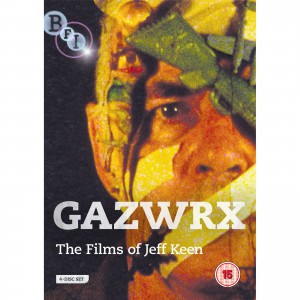2012. GB. BFI. DVD or Blu-ray. 585 minutes. £34.99
 About the Reviewer: Paul Newland teaches in the Department of Theatre, Film and Television Studies, Aberystwyth University. His publication include: British Films of the 1970s, Manchester: Manchester University Press (2012); Don’t Look Now: British Cinema in the 1970s, Bristol: Intellect (2010) (edited book); The Cultural Construction of London’s East End: Urban Iconography, Modernity, and the Spatialisation of Englishness, Amsterdam and New York: Rodopi (2008).
Email: pnn@aber.ac.uk
About the Reviewer: Paul Newland teaches in the Department of Theatre, Film and Television Studies, Aberystwyth University. His publication include: British Films of the 1970s, Manchester: Manchester University Press (2012); Don’t Look Now: British Cinema in the 1970s, Bristol: Intellect (2010) (edited book); The Cultural Construction of London’s East End: Urban Iconography, Modernity, and the Spatialisation of Englishness, Amsterdam and New York: Rodopi (2008).
Email: pnn@aber.ac.uk
The British Film Institute has released a sumptuously packaged boxed set which brings together the films of the Jeff Keen, one of the most important and challenging of British experimental filmmakers. This release contains over 9 hours of films and videos which encompass the visionary filmmaker’s 60s beatnik movies and his multi-layered videos of the 90s, including the celebrated Marvo Movie (1967) and Mad Love (1978). As such, this collection provides an excellent introduction and overview to the work of one maverick, independent, underground British filmmaker.
Formally, the films range from post-apocalyptic home movies to Keen’s reflections on his World War Two experiences, and often reflect his interest in the so-called ‘trash’ popular culture of B movies and comics, alongside surrealism. Keen (aka Dr Gaz) has been called Britain's answer to American underground cinema figures such as Stan Brakhage, Kenneth Anger and Andy Warhol. Born in 1923, the Brighton-based Keen started making 8mm films when he was nearing 40 – an inspiration to the late artistic developers among us. He helped develop the important London Film-makers Co-operative in 1966, and was a key figure in the development of Expanded Cinema. He died in July 2012 at the age of 88.
 The four DVDs in the box set present over forty of Keen’s films. What comes across on viewing this beautifully presented material is the vast range of Keen’s experimentation. Keen works with multiple screens and noise soundtracks, for example. He also uses a range of film stocks, preferring 8mm, which he saw as a potentially oppositional, disposable, form. His interest lies not with film as a form that might capture reality, but instead the potential richness of surreal visual imagery – how film images might have the power to problematize and pull at our experience of everyday life. He is a master of the processes of animation, of collage, and of rapid editing to set up powerful rhythms. Often images are cut together at a furious pace, and feature strobes or other bright lighting. Keen also often uses props – purloined from skips and rubbish dumps – and spray paints them. Sometimes these are set on fire and filmed. There is a wonderfully DIY/homemade aesthetic to much of his work, and the films often feature his family and friends. So, this collection offers much for the student of experimental filmmaking. It certainly demonstrates the importance of working with the materials you have available, the possibilities of creative independence, and the importance of taking creative risks.
The four DVDs in the box set present over forty of Keen’s films. What comes across on viewing this beautifully presented material is the vast range of Keen’s experimentation. Keen works with multiple screens and noise soundtracks, for example. He also uses a range of film stocks, preferring 8mm, which he saw as a potentially oppositional, disposable, form. His interest lies not with film as a form that might capture reality, but instead the potential richness of surreal visual imagery – how film images might have the power to problematize and pull at our experience of everyday life. He is a master of the processes of animation, of collage, and of rapid editing to set up powerful rhythms. Often images are cut together at a furious pace, and feature strobes or other bright lighting. Keen also often uses props – purloined from skips and rubbish dumps – and spray paints them. Sometimes these are set on fire and filmed. There is a wonderfully DIY/homemade aesthetic to much of his work, and the films often feature his family and friends. So, this collection offers much for the student of experimental filmmaking. It certainly demonstrates the importance of working with the materials you have available, the possibilities of creative independence, and the importance of taking creative risks.
The films in this set are framed in 1.33: (and close to 2.35:1 for the twin-screens). The excellent HD transfer emphasises the grain of the films, but also, importantly, the dirt, and the various postproduction manipulations. The first DVD includes early 16mm films, such as Cineblatz (1967), Rayday Film (1968-70 and 1976) and Dr G’s home movies, including The Cartoon Theatre of Dr Gaz (1976-9), and White Dust (1972). The second DVD includes Super 8mm and 16mm films such as Keen’s Family Star diary films, Self Portrait films and Artwar Super 8 films of the 1990s. The third DVD features more early 8mm films such as Wail (1960), Breakout (1962), Instant Camera (1964-5 and 2007) and The Pink Auto (1964). This disc also features Family Star Continued (The Mutt & Jeff Icecream Sundae + Mothman) and Self Portrait Continued (Spontaneous Combustion). The fourth DVD contains Keen's video works - Rayday Videos, Artwar Videos, and an informative documentary, Jeff Keen Films (1983), which shows the artist at work in Brighton.
The box set also features a beautifully designed and illustrated 96-page booklet including written contributions from Jack Sargeant, Tony Rayns, Raymond Durgnat and Keen himself. This collection is highly recommended.
Paul Newland